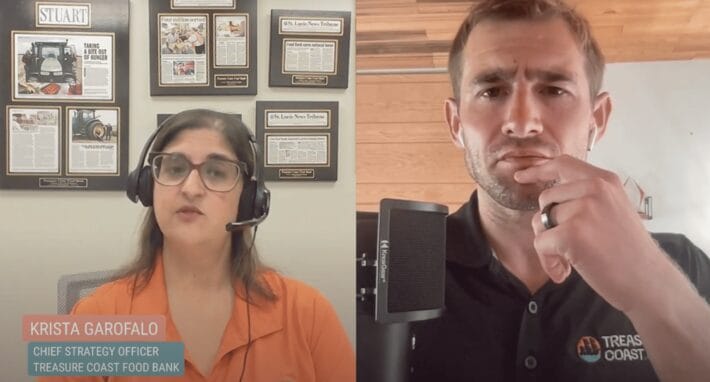In this episode of The Current by TreasureCoast.com, we speak with Krista Garofalo, Chief Strategy Officer of the Treasure Coast Food Bank, about the growing challenge of food insecurity across the Treasure Coast and the innovative programs they are using to fight it.
The Start of Treasure Coast Food Bank
Treasure Coast Food Bank has served the community since 1988, starting as a grassroots effort to support small food pantries that lacked resources and consistency. Over time, the organization has evolved into a strategic, multi-county operation serving St. Lucie, Martin, Indian River, and Okeechobee Counties. While it still distributes food through pantries and soup kitchens, today’s organization does much, much more. Its work targets the root causes of poverty and hunger, helping residents not just get by, but move forward.
About Food Insecurity on the Treasure Coast
Garofalo emphasizes that food insecurity isn’t just about a lack of food, but also about access to the right kinds of food and the ability to live a healthy and active life. One in four people on the Treasure Coast faces food insecurity, a number that includes many children, seniors, and even working adults. The Treasure Coast Food Bank’s mission is to bridge those gaps with food distribution and by addressing the underlying challenges that lead to the instability in the first place.
Treasure Coast Food Bank Programs that Fight Hunger
The conversation outlines the organization’s more than 20 active programs. These range from mobile pantries to school-based food services that feed children over weekends and holidays. Other efforts include senior delivery programs, benefits enrollment assistance for Medicaid and SNAP (food stamps), and even referrals for services like childcare and dental care.
One of the standout parts of the interview focuses on workforce development. The Treasure Coast Food Bank offers culinary training, barista and hospitality training, and commercial driver’s license (CDL) training. These programs are designed to give people practical skills that can lead to higher-paying jobs, helping them escape the cycle of poverty. Garofalo shares a moving story about a former trainee who went on to deliver materials for the construction of the organization’s new building. It’s a serendipitous tale that is proof of the long-term impact these programs have.
First Responder in Times of Need
When disaster strikes, the Treasure Coast Food Bank also acts as a first responder. During hurricanes or other emergencies, it provides meals, water, and supplies to affected communities. The team works year-round to train agencies and prepare emergency plans to ensure a fast and effective response when it matters most.
A Day at the Treasure Coast Food Bank
A typical day at the Food Bank is a coordinated team effort. Drivers hit the road early to collect food from partner retailers. Warehouse staff process incoming and outgoing shipments, volunteers arrive to help sort and package supplies, and curbside pickup appointments begin by 7:30 AM. Meanwhile, program staff fan out across the region to monitor partner sites, lead mobile distributions, or deliver prepared meals to seniors. In 2024, more than 11,000 volunteers contributed over 45,000 hours to the mission.
Garofalo explains that the organization takes a thoughtful approach to scaling partnerships and programs. They assess community needs, sustainability, and ensure that new initiatives can be maintained long-term. That includes vetting new partners, offering clear expectations for food safety and reporting, and building systems that can grow with local demand.
Importantly, she notes that requesting food assistance can be a deeply humbling and emotional experience. That’s why the Treasure Coast Food Bank uses a “self-declaration” process for most services. Clients don’t need to show ID or provide income documentation. They just declare that they need help. This simple, dignified system ensures that people can get food without barriers at a moment when they may already feel vulnerable.
Garofalo also highlights the unique needs of veterans, the homeless, and other underserved populations. Programs exist specifically for veterans’ housing communities and American Legion posts, as well as mobile grocery stores that accept SNAP and provide low-cost fresh produce. Some even receive home-delivered senior boxes and daily meals.
Challenges & Obstacles
Despite their wide reach, challenges remain. The biggest, Garofalo says, is shifting public understanding of who needs help and why. Many clients are working families, sometimes juggling multiple jobs with no healthcare or consistent hours. Rising costs for food, transportation, housing, and utilities are pushing more people to the edge. A single unexpected expense, she says, can send a household into crisis.
Nearly half of all Floridians live paycheck to paycheck. For those teetering on the edge, the Treasure Coast Food Bank is often the safety net that helps them stay afloat or turn the tide. The organization is also preparing for possible reductions in government support and public benefits, making their work even more vital.
How to Get Involved
For those looking to help, Garofalo encourages action. You can volunteer, donate, share the organization’s work on social media, or simply help educate others. Whether you give time, money, or attention, every contribution matters.
Visit stophunger.org or follow Treasure Coast Food Bank on social media to learn more and get involved.






